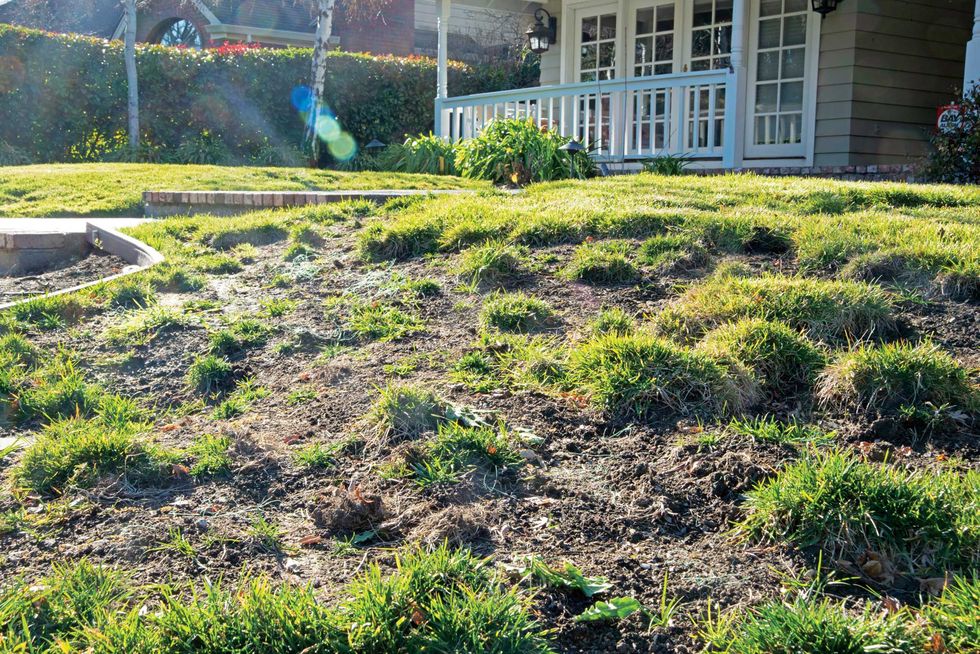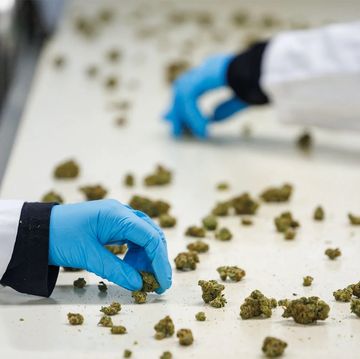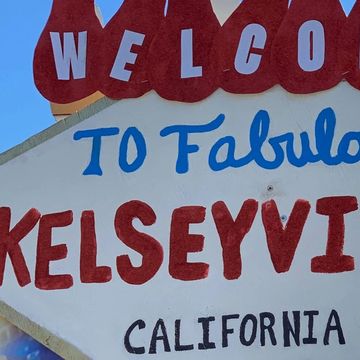At first they were isolated incidents, reported by TV newscasters struggling not to laugh. But as the sightings in California piled up, the phenomenon began to resemble the opening scene of a zombie movie.
In downtown Riverside, a pack of feral hogs marauded through the streets at night, causing millions of dollars in damage.
In Corona, a wild boar trailed a woman and her dog through a residential neighborhood.
In Ventura County, a car was damaged after hitting a giant hog ambling along Highway 126.
On Highway 1 in Central California, the breathtaking natural sights include feral pigs loitering along the side of the road.
On the border of Orange County and into the Inland Empire, packs of wild hogs living along the Santa Ana River often emerge, scaring hikers.
In San Jose, feral pigs regularly rampage through golf courses and front yards in search of food, leaving a trail of destruction.
In Monterey County and the Central Valley, wild hogs cause millions of dollars in damage to crops and land each year and threaten food safety.
On privately owned Tejon Ranch, off Interstate 5 near the Grapevine, thousands of wild boars roam the land, devouring deer fawns, uprooting plant, fungi, and animal spawn like frog eggs, and hoovering up acorns that could otherwise sprout into oaks on the 270,000-acre spread.
And that’s just the tip of the ecological-disaster iceberg.
Wild invasive pigs, which number between 6 million and 9 million nationally and cost the U.S. agriculture sector $2.5 billion annually in damage, have long been a problem in the American South. In Texas, where they’re hunted from helicopters with machine guns, millions of giant feral swine roam in herds, destroying ecosystems and crops, threatening the survival of other species, breeding uncontrollably, even at times killing humans.
Now, those same hogs are exploding across California’s parklands, wildlife preserves, ranches, canyons, wetlands, hillsides, and ravines—but also farms, suburbs, and country clubs. No one knows how many wild pigs call the state home, because they hide in undeveloped pockets of land, usually avoid humans, and are most active at night. But biologists estimate that there are 100,000—or possibly a lot more—living large in all 58 California counties, and their numbers are growing exponentially.
This article appears in the Spring 2022 issue of Alta Journal.
SUBSCRIBE
And just to be clear, these aren’t the cute little 35-pound javelinas native to the Southwest. These are invasive feral hogs that stand three feet high and five feet long, can reach 500 pounds, run 30 miles an hour, and sport long, dangerous tusks.
Wildlife biologists say you’d have to kill 70 percent of these pigs each year—which in California would likely mean at least 70,000 animals annually—just to stop their population from expanding. But fewer than 5,000 are killed in the state each year.
Hunting boars is legal year-round in California for those who obtain a permit, but hunters killed only 3,950 wild pigs in the 2020–21 season, according to the California Department of Fish and Wildlife. The department issued more than 1,700 additional permits to kill (or “depredate”) pigs in areas where they’ve become a hazardous nuisance.
Since we’ve significantly reduced the populations of so many of California’s apex predators, a 300-pound hog has few natural enemies left other than humans. Coyotes, pumas, and raptors might pick off the occasional piglet, and drought and other stressors might cause cyclical decline, but the majority of baby boars reach adulthood.
Wild pigs are the most fecund large mammal on Earth. Their life span is four to eight years, and sows reach maturity at between six and eight months, birthing up to 12 piglets a year when resources are plentiful. They live in extremely efficient matrilineal societies where sows and their daughters rear multiple generations together in groups called sounders; the males are solitary, showing up to mate and then skedaddling.
In fact, there’s an old adage that wildlife biologists like to drag out about this incredible animal that inspires reluctant admiration as well as alarm: If a sow births a litter of 8 piglets, 10 will survive.
“Unless we were to release packs of grizzly bears and wolves in huge numbers back to the California mountains, these wild pigs will survive,” says wildlife biologist Ben Teton. “They are completely unchecked by our native predators.” Teton researched wild pigs at the independent nonprofit the Tejon Ranch Conservancy and is now a preserve manager at Panoche Valley Preserve in Central California, working for the Center for Natural Lands Management.
Turns out that while we’ve all been prepping for doomsday scenarios and alien invasions, the “pig bomb” has already arrived.
SHOOT TO KILL
The majority of wild pigs roaming California today descend from wild Eurasian boars. Those swine first showed up in Florida, ferried on ships by Spanish explorers in the 1500s and released into the wilderness as a food source. The animals quickly adapted to their new surroundings, multiplying and expanding their territory each year. A much smaller number of today’s wild pigs descend from livestock that escaped farms across the country. The two have interbred widely, and biologists say most feral pigs today are hybrids.
Because pigs were domesticated only 9,000 years ago and are not that far removed genetically from their wild ancestors, they can quickly turn feral when let loose, shape-shifting into hulking, prehistoric-looking creatures. A domestic pig that escapes can develop large muscles and grow tusks to forage. Its skin can turn darker, grow coarse, and sprout bristly hair. Though wild pigs generally try to avoid people, they can become aggressive if they feel threatened. Pigs also expand their territory quickly, traveling between four and eight miles per year.
“We are seeing populations of wild pigs explode wherever there are resources, and it’s fatally underreported in the American West,” says Teton. “They’re incredible creatures. Depending on the resources available to them regarding food and refuge, they invent new strategies and pass those skills and strategies on to their offspring.”
But crafty animal instincts alone don’t account for the explosion of invasive wild pigs now plaguing California. Their expansion has been aided by humans who transport wild porkers and release them onto private land as big-game animals. In 2014, there were some 5,600 wild boars roaming Tejon Ranch (the number might be higher now). They were descended from one truckload of pigs released by a neighboring landowner as a game species on his Tehachapi property in the 1990s. The animals, which can dig under most fences, soon expanded into Tejon—the largest privately owned parcel in California.
Similar scenarios have played out across the state in recent years. The resulting plethora of pigs thrills trophy hunters. On private ranches, landowners charge up to $1,000 a day to hunt wild boars, says Eric Covington, the San Luis district supervisor for the U.S. Department of Agriculture’s Wildlife Services. “We take DNA samples, so we’re able to see where pigs are moving around from one part of the state to the other,” Covington says. “Are they traveling from San Luis Obispo to Mendocino County in two years? No, they’re being trucked in. We caught one once in California that had an Oklahoma Department of Agriculture tag on it. If that doesn’t tell you people are moving them around, I don’t know what does.”
This gets at the heart of California’s pig problem. For a lot of state residents, there’s gold in them thar pigs. Search the term “California pig hunt” and you’ll find many guided-tour companies that sponsor them. You’ll also find avid hunters swapping tips on which locations have had recent pig sightings; which public lands welcome hunters; which private ranches offer the best deals; the relative merits of crossbows, guns, and bows and arrows; and the best time to hunt pigs: dusk or dawn.
At Tejon Ranch, big-game aficionados bagged 1,200 wild hogs in 2014, though the numbers have declined since then owing to drought, the pandemic, and other variables. As of 2018, hunting generated $2 million annually for the company, with trophy seekers paying upwards of $20,000 for tailored safari experiences to shoot elk, deer, pigs, bears, and various game birds.
It’s unclear how a recently approved plan for the Tejon Ranch Company to build a brand-new city of 19,000 homes, called Centennial, near Interstate 5 and Highway 138 would affect things. On a recent visit, I saw a herd of giant boars galloping away from a vehicle traveling along a road inside the ranch. It was full daylight, and the animals were in the flats, where tall grasses and rolling hills give the property the feel of an African savanna.
The Tejon Ranch Company declined to discuss the invasive wild pigs on its property. “Thank you for the opportunity, but we are not interested in participating,” wrote Antone Mattias, the ranch’s natural resources and stewardship liaison.
But Tejon and other private landowners aren’t the only ones making money off pigs. The animals are a cash cow for the state’s Department of Fish and Wildlife, which raked in more than $1 million from pig-hunting permits in 2020. Some state and federal agencies in California even invite hunters onto their public lands, eager to earn the additional permit and entry fees paid by trophy hunters. State legislation introduced in January would affect that, replacing the $25-per-pig “tag” fee with a $15 base annual fee for hunting.
“Folks it is once again with great pleasure and excitement that I get to inform you that we will be hosting archery and crossbow pig hunts,” Joel Miller, then a supervisory park ranger with the U.S. Army Corps of Engineers at Northern California’s Lake Sonoma, posted on a popular hunting message board in 2015. Miller went on to thank hunters for their patronage and describe how their fees allowed the site to maintain trails, staff a visitor center, and expand camping cabins.
The warm welcome also reflected the fact that by killing invasive, destructive pigs, hunters perform a critical task for free. Without hunters, public preserves and forests overrun with wild pigs would have to hire expensive private contractors to cull the porcine population in areas where it threatens other wildlife, plants, water sources, or habitat. Today, that covers most woodlands in California.
But even when pigs are eliminated from an ecologically sensitive area, biologists say, that buys them only a year or two before new pigs move in and the process must be repeated.
While pigs have cemented alliances between hunters and some public land managers, their spread often pits the lucrative hunting industry against conservationists, who watch with mounting dismay as the invasive hogs destroy critical habitat and endangered species.
A TERROR TO TERRAIN
Farmers, vineyards, golf courses, other private businesses, resource managers, and even homeowners are alarmed by the growing destructiveness and near ubiquity of giant pigs.
“Imagine a beautiful oak-filled hillside, and it looks like a tractor came through and uprooted everything,” says Landon Peppel, the resource conservation director and Central Valley regional director for the Wildlands Conservancy. “Or the millions invested in a wetland. All that work, and the pigs get down into those riparian areas that are so important to many species, and they just annihilate it.”
In rivers and watersheds in Northern California’s coastal headlands, pigs threaten to undo decades of conservation efforts by biologists who have been working to protect salmon and other endangered species. “These are intelligent, adaptable, highly evolved mammals, to the great detriment of native species that have less adaptability,” says wildlife biologist Teton. “But everything that makes them so impressive is also what makes them so destructive. They will vacuum up acres of land in a given night, like it’s been rototilled.”
Wild pigs wreak havoc throughout California. They carry diseases, pollute water sources, break fences, destroy irrigation drip lines, erode soil, and threaten national food safety; they may have contributed to a 2006 E. coli outbreak traced to raw spinach that killed five people and sickened hundreds. “There are now pigs that live entirely in agricultural lands,” says Teton.
The USDA’s Covington says that an investigation confirmed pig activity in the spinach fields and open waterways where the outbreak originated and that the E. coli strain that killed people was found in the feces of wild pigs. Because the pathogen is also found in domestic animals, no direct link could be established. Nonetheless, fear of contamination by wild pigs has become so acute that some produce buyers won’t purchase from farms where they spot signs like rooting, wallowing, cloven-hoof prints, or pig scat, Covington says. The land is usually plowed under, since the risk of contaminating the food supply is too great.
“Almost all the wild pigs are infected with something,” says Teton. This can include pseudorabies, trichinosis, African swine fever, tularemia, various parasites, plague, and brucellosis, which can be deadly to livestock and also humans if not quickly treated. “The nightmare scenario is what could happen if a diseased wild pig came into contact with domestic swine,” he says. “It could kneecap our economy.”
The feds are finally listening. In 2019, the USDA set up the $75 million Feral Swine Eradication and Control Pilot Program to study the threat that swine pose to agriculture, ecosystems, and the health of humans and animals. But the program targets the southern states with the biggest wild pig problems and does not include California.
So what’s the Golden State to do? Wildlife biologists say it’s way past time to reclassify wild pigs from a big-game mammal (like elk or mule deer) to an agricultural pest. While this would mean an end to hunting-permit revenues, it would also lift many restrictions on killing wild swine, as many other states plagued by them have already done.
Municipal laws provide another challenge. At Coyote Creek Golf Club near San Jose, wild pigs inflict $50,000 in damage a month, but shooting them inside city limits is against the law, and you can’t exactly catch them with a butterfly net. The Northern California towns of Moraga, San Ramon, and Lafayette all have hog problems. But even as pigs become entrenched in suburbs and on agricultural land, many local laws severely limit the ability of municipalities to kill them.
Scientists say more research money is urgently needed to study the life cycle of wild pigs, using methods like tagging, collaring, remote cameras, and autopsies. But it’s hard, dangerous work, and the animals usually take off like Olympic sprinters at the first sign of humans, heading for remote, inhospitable ravines and canyons where bipeds can’t follow. Add to that their camouflage capabilities: wild boars are often jet black and almost invisible at night, when they’re most active. “These are very dynamic landscapes,” says Teton. “You don’t just traipse around and count them.”
Hopes are high for a multiagency, multiyear study of wild pigs unfolding at several venues nationwide. At Tejon Ranch, researchers spent several years capturing and collaring around 100 wild pigs, setting up motion-activated cameras, tracking the animals, and collecting data, says Michael White, a scientist who oversaw the project for the Tejon Ranch Conservancy and now works as a consultant for the nonprofit.
But the Tejon Ranch Company eventually terminated the project because it would have required scientists to kill and autopsy some pigs, which the ranch considered incompatible with its hunting operations. “We were not able to complete the research the way we had hoped,” says Teton, who left the Tejon Ranch Conservancy in 2018. “All the active research was shut down.”
The need to research wild swine comes at a time when agencies with limited resources are reeling from climate change. But scientists say the pig invasion and climate change are fatally intertwined. With drought and wildfires ravaging California, it’s crucial to protect waterways from pollution and destruction by pigs and to give native plants a chance to recover. In San Diego County, a report prepared by the Conservation Biology Institute for the Nature Conservancy found that wild pigs already live along one of the county’s major watersheds and threaten water quality. They also contribute to species extinction by hogging natural resources and destroying sensitive habitat that birds, animals, fish, and plants depend on.
Despite persuasive arguments for culling wild swine, the topic remains controversial—after all, we are talking about mass killings of wild animals, albeit incredibly destructive ones. Because of this, some public agencies don’t want to discuss their pig-eradication programs for fear of riling up PETA and other animal rights groups. In fact, several nonprofit nature-conservancy groups contacted for this story declined to comment on their depredation programs.
But behind the scenes, those agencies and groups obtain permits and hire sharpshooters to kill nuisance pigs. Embattled farmers leave food in open corrals, accustom the pigs to entering for free meals, then slam the gates shut once the pigs relax their vigilance. (Trapped pigs are then slaughtered.) Perhaps the most biblical form of culling is the Judas pig: A captured swine fitted with a GPS collar is released and leads exterminators to where other pigs are hiding. The entire group is killed, except for the Judas pig, which is released again to find another herd, where the grisly operation repeats.
Scientists are also working on chemicals that would render male boars sterile without affecting the health or reproductive capacity of other wildlife. The makers of HogStop, a product already on the Texas market, claim that it reduces the sperm count of male boars by 60 percent.
As for Teton, he’d like to see wild-boar meat—now a pricey delicacy at high-end restaurants—become a cheap, lean, nutritional protein option, so long as it’s thoroughly cooked to kill pathogens. Making wild-boar meat as ubiquitous as hot dogs (boar dogs?) could help diminish the pigs’ numbers.
But the USDA requires that any animal sold commercially for its meat undergo federal inspection while still alive. Which means that hunters can eat and give away the wild boars they catch, but they can’t sell them. (The wild-boar meat at your favorite upmarket grocery store usually comes from a large industrial producer that has the necessary infrastructure.)
In the meantime, wildlife biologists watch with trepidation as the wild pigs multiply and governmental response lags. “Just getting the average citizen to understand the gravity of this situation is absolutely critical,” says Teton. “This is an out-of-control train. It’s an invasion. There’s armies of them, just out of sight. But the armies are growing.”•
Denise Hamilton is a Los Angeles native, crime novelist, and former reporter for the Los Angeles Times. She’s the editor of Los Angeles Noir and Los Angeles Noir 2: The Classics and was a finalist for the Edgar Award. Read more about her at denisehamilton.com.














